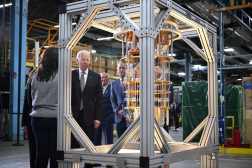 Artist’s concept of robots competing in the DARPA Robotics Challenge. (Image: DARPA)
Artist’s concept of robots competing in the DARPA Robotics Challenge. (Image: DARPA)The National Institute of Standards and Technology’s upcoming robotics challenge will feature emergency-response robots that can perform in real disaster situations.
Research teams from around the world will be competing Dec. 20-21 in the trials of the Defense Advance Research Projects Agency Robotics Challenge.
The challenge will present a mock-up disaster scenario prompted by Japan’s Fukushima Daiichi nuclear disaster, which occurred when the 2011 earthquake struck the country. Teams will direct their robots to perform eight basic tasks inspired by the Fukushima Daiichi response, and then from there be converted into standardized tests by NIST researchers.
“The DARPA Robotics Challenge is a great learning opportunity for the robotics community and a chance for NIST to demonstrate how standard performance tests help to inspire and guide innovation while measuring progress in a diverse, fast-moving area of technology,” said Adam Jacoff, engineer and leader of the NIST testing program.
According to DARPA, the goal of the competitive is to spur cost-effective hardware and software innovations that will lead to robots of the future performing crucial tasks during or in the aftermath of a disaster.
NIST has worked with the Department of Homeland Security to establish standardized performance testing for robots used in bomb-response and search-and-rescue operations. Fifteen NIST tests have been adopted as standards by ASTM International since 2005; about 40 or more are currently in the development and review process.
Robot contestants will spend the first two weeks of December driving a utility vehicle through a slalom course, dismount and traverse complex obstacles. Other tasks involve opening doors, climbing ladders, removing debris from entryways, using tools to cut a hole through a wall, closing and opening valves and connecting a hose.
Teams receive points for each completed task within a 30-minute time limit.
Below, is a video by NIST on its latest robot challenge endeavor:






